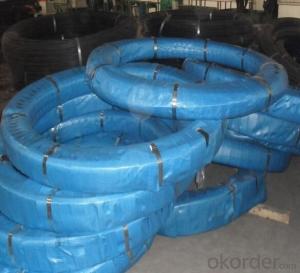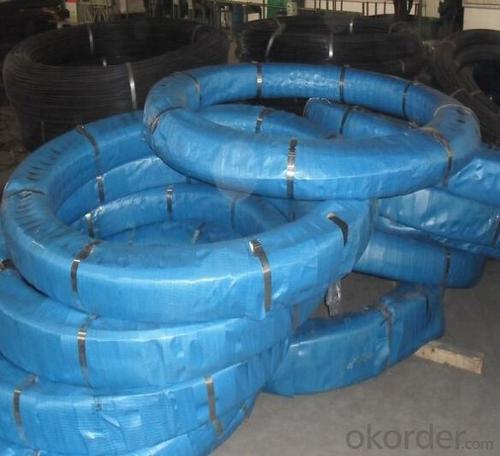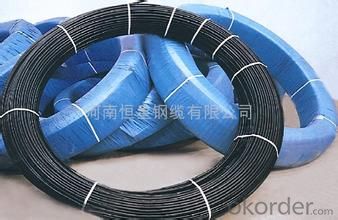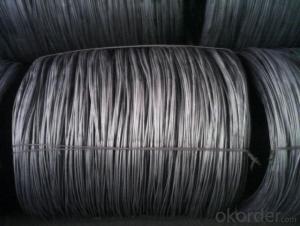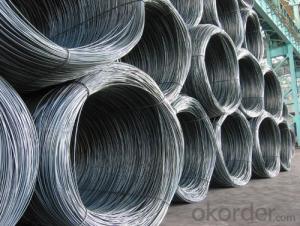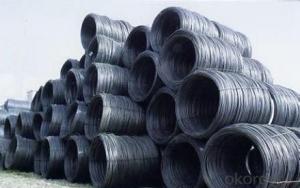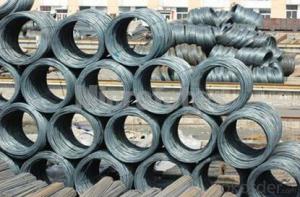Prestressed Hot Rolled Steel Wire
- Loading Port:
- China Main Port
- Payment Terms:
- TT or LC
- Min Order Qty:
- 25-30 m.t.
- Supply Capability:
- -
OKorder Service Pledge
OKorder Financial Service
You Might Also Like
Packaging & Delivery
| Packaging Detail:steel strand coil to be packed in damp proof materials strapped with 8 bands on one wooded pallet with an outer layer of plastic used for anti-rainshower 2 or 3 wooden block undermeath each coil. |
|
| Delivery Detail:within 2 weeks |
Specifications
high carbon class A steel wire
Constructon:7 steel wire
material:wire 82B
FAQ of Prestressed steel wire:
①How is the quality of your products?
Our products are manufactured strictly according to national and internaional standard. If you want see our quality certifications and all kinds of testing report, please just ask us for it.
Guaranteed: If products’ quality don’t accord to discription as we give or the promise before you place order, we promise 100% refund.
②How about price?
Yes, we are factory and be able to give you lowest price below market one, and we have a policy that “ for saving time and absolutely honest business attitude, we quote as lowest as possible for any customer, and discount can be given according to quantity”,if you like bargain and factory price is not low enough as you think, just don’t waste your time.Please trust the quotation we would give you, it is professional one.
③Why should you chose us?
Chose happens because of quality, then price, We can give you both.Additionally, we can also offer professional products inquiry, products knowledge train(for agents), smooth goods delivery, exellent customer solution proposals.Our service formula: good quality+good price+good service=customer’s trust
SGS test is available, customer inspection before shipping is welcome, third party inspection is no problem.
Prestressed Steel Wire Images

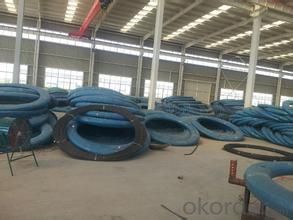
- Q: What are the different types of corrosion resistance tests conducted on steel wire rod?
- There are several types of corrosion resistance tests conducted on steel wire rods, including salt spray testing, cyclic corrosion testing, atmospheric exposure testing, electrochemical testing, and accelerated corrosion testing. These tests aim to simulate different environmental conditions and assess the ability of the steel wire rod to withstand corrosion in various settings.
- Q: How is steel wire rod used in the manufacturing of tire reinforcement?
- Steel wire rod is used in the manufacturing of tire reinforcement as it provides strength and durability to the tires. It is typically used to make the steel belts that are embedded in the tires, which helps to provide stability, prevent the tire from deforming under pressure, and enhance overall performance and safety.
- Q: What are the different transportation methods for steel wire rod?
- The different transportation methods for steel wire rod include trucking, rail transportation, and shipping via cargo vessels.
- Q: How is steel wire rod used in the production of wire strands for cable-stayed bridges?
- Steel wire rod is a crucial component in the production of wire strands for cable-stayed bridges. These wire strands are essential for providing structural stability and load-bearing capacity to the bridge. To begin with, steel wire rods are manufactured with precise chemical compositions and mechanical properties to ensure their suitability for this application. These wire rods are typically made from high-strength steel alloys, such as carbon or alloy steel, which can withstand the immense tension and stress experienced by cable-stayed bridges. The first step in the production process involves drawing the steel wire rod through a series of dies to reduce its diameter. This process, known as wire drawing, imparts a higher tensile strength to the wire strand by aligning the crystal structure of the steel and eliminating impurities. The resulting wire strand is now capable of withstanding substantial loads. Once the wire strands are formed, they are galvanized or coated with a corrosion-resistant material. This coating protects the steel from environmental factors, such as moisture and chemicals, which could cause corrosion and compromise the integrity of the bridge. After the wire strands have been coated, they are assembled into bundles to form the cable-stayed bridge's main supporting structure. The number of wire strands used, along with their arrangement and tensioning, depends on the design requirements of the specific bridge. These wire strands are typically anchored to the bridge deck and tower, providing support and distributing the load across the structure. The final step involves tensioning the wire strands to their specified levels, ensuring that they can bear the anticipated loads and maintain the bridge's stability. This tensioning process is crucial for achieving the desired sag and shape of the bridge, as well as distributing the forces evenly among the wire strands. In summary, steel wire rod plays a vital role in the production of wire strands for cable-stayed bridges. It provides the necessary strength and durability to withstand the immense loads and forces exerted on these structures. Through a series of manufacturing processes, the wire rod is transformed into wire strands that are galvanized, bundled, and tensioned to create a stable and reliable supporting system for cable-stayed bridges.
- Q: What are the common applications of low alloy steel wire rod?
- Due to its specific properties and characteristics, low alloy steel wire rod finds various common applications across different industries. Some of the most prevalent uses of this material include: 1. Construction industry: Low alloy steel wire rod plays a significant role in reinforcing concrete structures within the construction industry. It is extensively utilized in the production of welded wire mesh, which reinforces concrete slabs, walls, and foundations. The exceptional strength and durability of low alloy steel wire rod make it an ideal choice for withstanding heavy loads and preventing structural failure. 2. Automotive industry: The automotive industry heavily relies on low alloy steel wire rod for manufacturing various components. It is commonly employed in the production of springs, suspension systems, and other high-stress components that demand exceptional strength and fatigue resistance. The ability of low alloy steel wire rod to endure heavy loads and constant stress makes it well-suited for automotive applications. 3. Manufacturing industry: Various manufacturing processes utilize low alloy steel wire rod. It is widely employed in the production of fasteners, such as screws, bolts, and nuts, due to its high tensile strength. Additionally, this material is used to manufacture wire ropes, cables, and other high-strength wire products that require durability and resistance to corrosion. 4. Engineering industry: The engineering industry relies on low alloy steel wire rod to fabricate structural components, machinery parts, and equipment. It is frequently employed in the manufacturing of gears, shafts, and bearings due to its excellent wear resistance and ability to withstand heavy loads. The properties of low alloy steel wire rod make it a reliable choice for critical engineering applications. 5. Electrical industry: In the electrical industry, low alloy steel wire rod is utilized for manufacturing various electrical conductors and components. It is commonly employed in the production of overhead power lines, electrical cables, and wires due to its high electrical conductivity and mechanical strength. The ability of low alloy steel wire rod to efficiently carry electricity and withstand mechanical stress makes it suitable for electrical applications. In conclusion, the versatility of low alloy steel wire rod allows it to be widely used in the construction, automotive, manufacturing, engineering, and electrical industries. Its high strength, durability, wear resistance, and electrical conductivity make it an excellent choice for applications that require reliability and performance.
- Q: What are the common raw materials used in steel wire rod production?
- The common raw materials used in steel wire rod production are iron ore, coal, limestone, and scrap metal.
- Q: What is the standard size range for steel wire rod?
- The standard size range for steel wire rod typically varies depending on the specific application and industry requirements. However, common sizes for steel wire rod usually range from 5.5 millimeters (mm) to 25 mm in diameter. These sizes are commonly used in various industries such as construction, automotive, manufacturing, and electrical. It is important to note that different steel wire rod grades may have specific size ranges determined by their intended use and mechanical properties.
- Q: What are the different types of steel wire rod coatings used for increased strength?
- The different types of steel wire rod coatings used for increased strength include galvanized coatings, zinc-aluminum coatings, and epoxy coatings.
- Q: How is steel wire rod used in the manufacturing of wire for bicycle spokes?
- Steel wire rod is an essential component in the manufacturing of wire for bicycle spokes. It serves as the raw material from which the wire is produced. The process begins with the steel wire rod being drawn through a series of dies to reduce its diameter and increase its length. This drawing process helps to strengthen the wire and improve its overall quality. Once the wire has been drawn to the desired diameter, it is then further processed to make it suitable for bicycle spokes. This involves a process called cold forging, where the wire is bent and shaped into the desired form. Cold forging helps to enhance the wire's strength and durability, ensuring it can withstand the rigors of bicycle use. After the cold forging process, the wire is often subjected to additional treatments, such as heat treatment or galvanization. Heat treatment helps to further strengthen the wire, while galvanization involves coating the wire with a layer of zinc to protect against corrosion. The final step in the manufacturing of wire for bicycle spokes involves cutting the wire to the desired length and threading it onto a spoke nipple. This completes the production process, resulting in a strong and reliable wire that can be used to build sturdy and durable bicycle spokes. In summary, steel wire rod plays a crucial role in the manufacturing of wire for bicycle spokes. It serves as the starting material, undergoes various processes to enhance its strength and durability, and ultimately forms the backbone of a reliable and high-quality spoke.
- Q: What are the main factors affecting the price of steel wire rod?
- The main factors affecting the price of steel wire rod include the cost of raw materials, such as iron ore and scrap metal, as well as energy prices and transportation costs. Market demand and supply dynamics also play a significant role, along with global economic conditions, trade policies, and currency fluctuations. Additionally, factors like production capacity, technological advancements, and government regulations related to environmental and safety standards can impact the price of steel wire rod.
Send your message to us
Prestressed Hot Rolled Steel Wire
- Loading Port:
- China Main Port
- Payment Terms:
- TT or LC
- Min Order Qty:
- 25-30 m.t.
- Supply Capability:
- -
OKorder Service Pledge
OKorder Financial Service
Similar products
Hot products
Hot Searches
Related keywords
